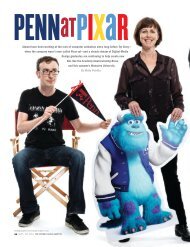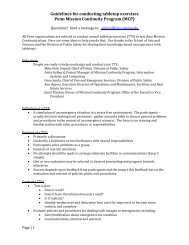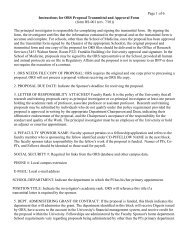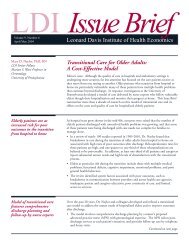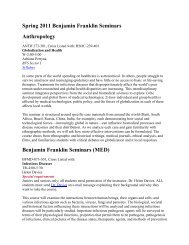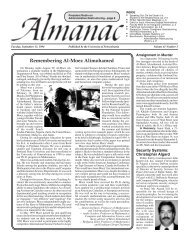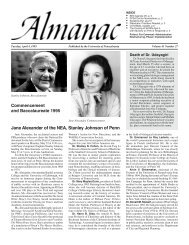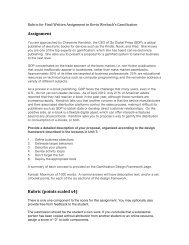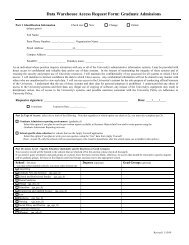Download this article (PDF) - University of Pennsylvania
Download this article (PDF) - University of Pennsylvania
Download this article (PDF) - University of Pennsylvania
You also want an ePaper? Increase the reach of your titles
YUMPU automatically turns print PDFs into web optimized ePapers that Google loves.
Consider the circumstances: First announced in early 1973, it As they walked past the decrepit 1850s smallpox hospital known<br />
went through major changes in scope and materials as Kahn’s as the Renwick Ruin and approached the row <strong>of</strong> copper beeches<br />
vision adjusted to budgetary realities and his clients’ taste. standing sentinel at the park’s entrance, Whitaker could sense<br />
Then in March 1974, shortly before the final schematic designs Pattison’s anxiety. She had been cut <strong>of</strong>f from the project for nearly<br />
were approved, Kahn suffered a fatal heart attack in a Penn 40 years, and the one time she had been asked to attend a meeting<br />
Station men’s room. His debt-strapped Philadelphia <strong>of</strong>fice was with the key players two decades ago, her frustrations had spilled<br />
promptly shuttered, and most <strong>of</strong> his employees—including out. She was not asked back, and her isolation from the project<br />
some key colleagues—were let go. Mitchell/Giurgola Architects’ only grew. By now she was dreading what she might find.<br />
New York <strong>of</strong>fice, run by Kahn’s friend Aldo Giurgola, took over “I think anyone who’s been involved in architecture, when<br />
the project, but the following year New York City was rocked by you go and visit a building under construction, when it’s being<br />
an epic financial crisis. Between that and a series <strong>of</strong> changing finished—and you were a part <strong>of</strong> it—you get incredibly excited,”<br />
political administrations and sympathies, Four Freedoms Park says Whitaker, whose thick head <strong>of</strong> brown-gray hair and steady<br />
was more or less dead in the East River for more than three gaze somehow combine to suggest a boyish unflappability.<br />
decades, its empty site coveted by developers.<br />
“Because you see all the wonder—and all the flaws.”<br />
Building anything designed by a dead<br />
architect is considered a fool’s errand. By<br />
the time the plans got jump-started seven<br />
years ago, the world—and certain codes<br />
relevant to architecture—had changed.<br />
Kahn was famous for last-minute alterations,<br />
and he might well have made some<br />
more had he lived. Yet any interpretations<br />
<strong>of</strong> his vision by others were bound<br />
to stir powerful passions.<br />
Over the past few years, Whitaker had<br />
become deeply involved in the project.<br />
Trained as an architect himself, and<br />
intimately familiar with Kahn’s work<br />
(the Kahn Collection forms the keystone<br />
<strong>of</strong> the Architectural Archives and represents<br />
the most significant repository <strong>of</strong><br />
Kahn materials in the world), Whitaker<br />
had painstakingly recreated the evolution<br />
<strong>of</strong> Four Freedoms Park. His scholarly<br />
detective work—call it forensic architecture—would<br />
prove invaluable.<br />
Bill Whitaker: “If you don’t use the Kahn Collection for a project like <strong>this</strong>, why have it in the first place?”<br />
Now, on <strong>this</strong> rainy October morning,<br />
Whitaker suddenly had a sobering realization—that<br />
despite having given hundreds <strong>of</strong> tours <strong>of</strong> Kahn’s By the time Four Freedoms Park opened on October 17—with a<br />
buildings over the years, <strong>this</strong> was the first time he had ever ribbon-cutting ceremony presided over by Bill Clinton, Michael<br />
visited one that was brand new. And in just a few hours he would Bloomberg, Andrew Cuomo, and Tom Brokaw—few architectural<br />
critics were finding flaws. On the contrary; the critical<br />
be leading a tour <strong>of</strong> the memorial for a large contingent <strong>of</strong> Penn<br />
Design alumni and friends—not exactly a lightweight crowd, reviews bordered on the ecstatic.<br />
since many had known Kahn personally, some had studied “It gives New York nothing less than a new spiritual heart,”<br />
under him, and all revered him and his work.<br />
wrote Michael Kimmelman in the September 12 New York<br />
The two passengers in Whitaker’s car had even deeper connections.<br />
One was Harriet Pattison GLA’67, the landscape architect the prow <strong>of</strong> a ship and a retreat for meditation.”<br />
Times. “It creates an exalted, austere public space, at once like<br />
and romantic companion <strong>of</strong> Kahn who had worked closely with him “It is the first time a work <strong>of</strong> posthumous architecture has<br />
on the landscape side <strong>of</strong> the memorial for the last 13 months <strong>of</strong> his made me feel elated, not <strong>of</strong>fended, and left me absolutely certain<br />
life, only to be let go a few days after his death. The other was their that the right thing had been done,” wrote Vanity Fair critic Paul<br />
son, Nathaniel Kahn, whose brilliant, poignant film, My Architect: Goldberger, after listing some <strong>of</strong> the sobering challenges that face<br />
A Son’s Journey, is widely credited with bringing his father’s work anyone trying to realize a dead architect’s vision. “Kahn designed<br />
to a broad audience—and with rekindling interest in the moribund buildings that were modern and at the same time looked as if<br />
FDR memorial. In recent years Whitaker had gotten to know both <strong>of</strong> they had been there forever,” he added. “Build it in 1974, build it<br />
them well, and the more he learned the more he came to appreciate in 2012—when it is Louis Kahn it doesn’t seem quite to matter as<br />
the vital but unknown role Pattison had played in the memorial’s much as it would with some other architect’s work.”<br />
design. She had also given the archives more than 100 drawings And yet little things, as well as big, mattered terribly to<br />
and other materials pertaining to the project.<br />
Kahn—from the precise texture <strong>of</strong> concrete or stone to the<br />
38 MARCH | APRIL 2013 THE PENNSYLVANIA GAZETTE



